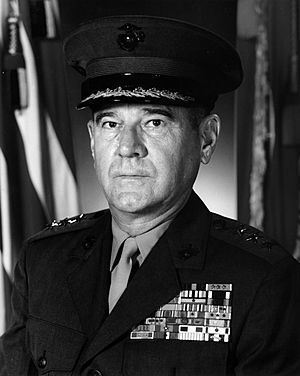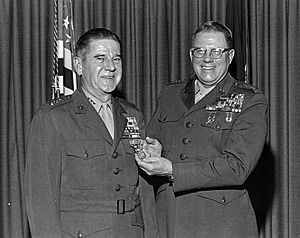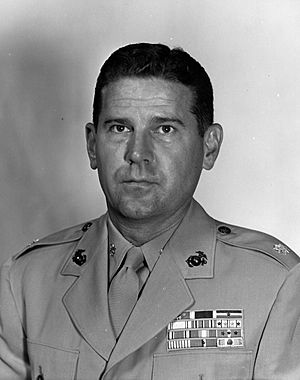Leo J. Dulacki facts for kids
Quick facts for kids
Leo J. Dulacki
|
|
|---|---|

LTG Leo J. Dulacki, USMC
|
|
| Birth name | Leo John Dulacki |
| Born | December 29, 1918 Omaha, Nebraska, U.S. |
| Died | January 4, 2019 (aged 100) Sun City West, Arizona, U.S. |
| Allegiance | United States of America |
| Service/ |
|
| Years of service | 1941–1974 |
| Rank | |
| Service number | 0-8129 |
| Commands held | 5th Marine Division 4th Marine Division Chief of Staff of III MAF 1st Battalion, 7th Marines |
| Battles/wars | World War II
|
| Awards | Distinguished Service Medal (2) Legion of Merit (4) Bronze Star Medal (2) Purple Heart |
Leo John Dulacki (December 29, 1918 – January 4, 2019) was a very important leader in the United States Marine Corps. He became a lieutenant general, which is a very high rank. He served his country for 32 years.
During his time in the Marines, Dulacki worked on important intelligence missions. He even worked in countries like Moscow and Helsinki. He ended his career helping to manage all the people in the Marine Corps.
He fought in three major wars: World War II, the Korean War, and the Vietnam War. In World War II, he was on a ship called the USS Hornet when it sank. In Korea, he led a group of Marines and was hurt, but he was recognized for his bravery. He also served two times in Vietnam.
Contents
Early Life and World War II Service
Leo John Dulacki was born on December 29, 1918, in Omaha, Nebraska. His parents, Stanley and Anna Dulacki, were immigrants from Poland. He finished Omaha South High School in 1936.
After high school, he went to Creighton University. There, he played golf and was part of the chemistry club. He also led the Polish Club and the Student Union Board. In June 1941, he earned a science degree. He then became a second lieutenant in the Marine Corps through a program called ROTC.
Dulacki officially joined the Marine Corps as a second lieutenant on September 2, 1941. He went to the Basic School in Philadelphia for officer training. After training, he joined the Marine group on a new aircraft carrier, the USS Hornet. This was just before the Japanese attack on Pearl Harbor.
The USS Hornet took part in the Doolittle Raid on Tokyo in April 1942. This was a daring air attack. Dulacki was promoted to first lieutenant in September 1942. He was also on the Hornet during the Battle of Midway in June 1942.
The Hornet was later sunk during the Battle of the Santa Cruz Islands in October 1942. Dulacki was rescued and sent to Pearl Harbor, Hawaii. He became a captain in March 1943.
He then took command of the Marine group on another new ship, the USS Belleau Wood. He fought in the Gilbert and Marshall Islands and Mariana and Palau Islands campaigns in 1944. He was promoted to major in January 1944.
The Belleau Wood was badly damaged by a kamikaze attack in October 1944. A kamikaze was a Japanese pilot who crashed his plane into enemy ships. The ship went to California for repairs. Dulacki left the ship in early 1945. He then became the officer in charge of a Marine Corps recruiting office in Kansas City, Missouri.
After the War: New Missions
Dulacki stayed in Kansas City until 1947. Then, he went to a special course for Marines at Quantico. After finishing the course, he helped start the Marine Recruiters School at Marine Corps Recruit Depot Parris Island. He led this school until June 1948.
He then went to Guam and worked as an assistant operations officer for a Marine group. In November 1948, he returned to the United States. He studied Russian at the Army Language School in Monterey, California.
After learning Russian, Dulacki went to Washington, D.C.. He studied at the Strategic Intelligence School. Then, he moved to Finland and worked at the American Embassy in Helsinki. He was promoted to lieutenant colonel in January 1951. The government of Finland gave him a special award called the Commander's Cross of the Order of the Lion of Finland.
In August 1952, Dulacki went to Korea. He took command of the 1st Battalion, 7th Marines. His group was fighting on the Jamestown Line. This was a line of defenses with bunkers and outposts. In October 1952, Chinese forces attacked. Dulacki was hurt by an enemy artillery shell, but he kept leading his battalion.
He successfully defended his positions during the First Battle of the Hook. He stayed in command until November 1952. He received the Bronze Star Medal for his bravery in Korea.
After his command, Dulacki joined the team that worked on the Korean Truce negotiations. He helped with the peace talks at Panmunjom in July 1953. He also helped with the return of prisoners of war. He received a second Bronze Star Medal for this work.
Dulacki returned to the United States in August 1953. He continued his studies at Quantico. After graduating, he became an instructor in intelligence. In 1956, he joined the 1st Marine Division at Camp Pendleton, California. He served as an executive officer and then helped with logistics.
During the Cold War, a time of tension between the U.S. and the Soviet Union, Dulacki went to Moscow in June 1958. He worked at the American embassy there. He was promoted to colonel in November 1959. He received the Legion of Merit for his work in Moscow.
He returned to the U.S. in June 1961. He worked for the Joint Chiefs of Staff and then the Defense Intelligence Agency. He received the Joint Service Commendation Medal for his service. In 1964, he attended the Naval War College in Newport, Rhode Island. He also earned a master's degree in International Affairs from George Washington University.
Vietnam War Service
In July 1965, Dulacki went to South Vietnam. He joined the headquarters of the III Marine Amphibious Force (III MAF) in Da Nang. He was in charge of intelligence, gathering and analyzing information. This information was very important for operations like Starlite and Harvest Moon.
He served there until January 1966 and received a second Legion of Merit for his service. He then moved to the 3rd Marine Division and became its chief of staff. He helped plan search and destroy missions. He also saw the Buddhist Uprising, a time of protests.
Dulacki returned to the U.S. in May 1966 and received a third Legion of Merit. He then worked at Headquarters Marine Corps. In August 1967, he became a brigadier general. He was appointed assistant director of personnel.
In June 1968, Dulacki went to Camp Pendleton, California. He became the assistant division commander of the 5th Marine Division. This division trained reserve Marines. He took command of the division in July 1968 and served until May 1969. He received a fourth Legion of Merit for his work there.

Dulacki returned to South Vietnam in June 1969 for his second tour. He became the operations officer for the III MAF. He helped plan the movement of the 3rd Marine Division to Okinawa. He also helped plan and carry out several search and destroy operations. These operations caused heavy losses for the enemy.
He became chief of staff of III MAF in December 1969. He continued in this role until June 1970. For his service in Vietnam, Dulacki received the Navy Distinguished Service Medal. He also received several awards from Vietnam and Korea.
After returning, Dulacki took command of the 4th Marine Division at Camp Pendleton. He was again in charge of training Marine reservists. He was promoted to major general on August 17, 1970. He led the division until March 1973.
Dulacki then worked as the Inspector General of the Marine Corps. On May 14, 1973, he was promoted to lieutenant general. He became the director of personnel for the Marine Corps. He retired from the Marine Corps on January 1, 1974, after almost 32 years of service. He received his second Navy Distinguished Service Medal at his retirement ceremony.
Life After the Marines
After retiring, Dulacki lived in Carlsbad, California. He was active in several groups. He was on the board of trustees for the Kosciuszko Foundation and the Devil Pups Youth Foundation. He also advised the National Armed Forces Museum at the Smithsonian Institution.
He was honored by his university, Creighton University, in 1974. In 1990, he was added to the Attache Hall of Fame of the Defense Intelligence Agency. His high school, Omaha South High School, also honored him in 2013.
Leo John Dulacki passed away on January 4, 2019, in Sun City West, Arizona. He was 100 years old.
Decorations
Here is a list of the medals and awards General Dulacki received:
| 1st Row |
Navy Distinguished Service Medal with one 5⁄16" Gold Star | |||||||||||||||
|---|---|---|---|---|---|---|---|---|---|---|---|---|---|---|---|---|
| 2nd Row |
Legion of Merit with Combat "V" and three 5⁄16" Gold Stars | Bronze Star Medal with Combat "V" and one 5⁄16" Gold Star | Joint Service Commendation Medal | Navy Commendation Medal | ||||||||||||
| 3rd Row |
Purple Heart | Navy Presidential Unit Citation with one star | Navy Unit Commendation | American Defense Service Medal | ||||||||||||
| 4th Row |
American Campaign Medal | Asiatic-Pacific Campaign Medal with two 3/16 inch silver and two bronze service stars | World War II Victory Medal | National Defense Service Medal with one star | ||||||||||||
| 5th Row |
Korean Service Medal with three 3/16 inch silver service star | Vietnam Service Medal with four 3/16 inch bronze service stars | Order of the Lion of Finland, rank Commander | Korean Order of Military Merit, 5th Class | ||||||||||||
| 6th Row |
National Order of Vietnam, Knight | Vietnam Gallantry Cross with Bronze Star | Philippine Republic Presidential Unit Citation | Republic of Korea Presidential Unit Citation | ||||||||||||
| 7th Row |
Vietnam Gallantry Cross Unit Citation | Philippine Liberation Medal with one star | United Nations Korea Medal | Vietnam Campaign Medal | ||||||||||||
See also
- 4th Marine Division
- 5th Marine Division
| Military offices
|
||
|---|---|---|
| Preceded by Donn J. Robertson |
Commanding General of the 4th Marine Division July 15, 1970 – March 4, 1973 |
Succeeded by John N. McLaughlin |
| Preceded by Wood B. Kyle |
Commanding General of the 5th Marine Division July 18, 1968 – May 1, 1969 |
Succeeded by Donn J. Robertson |




